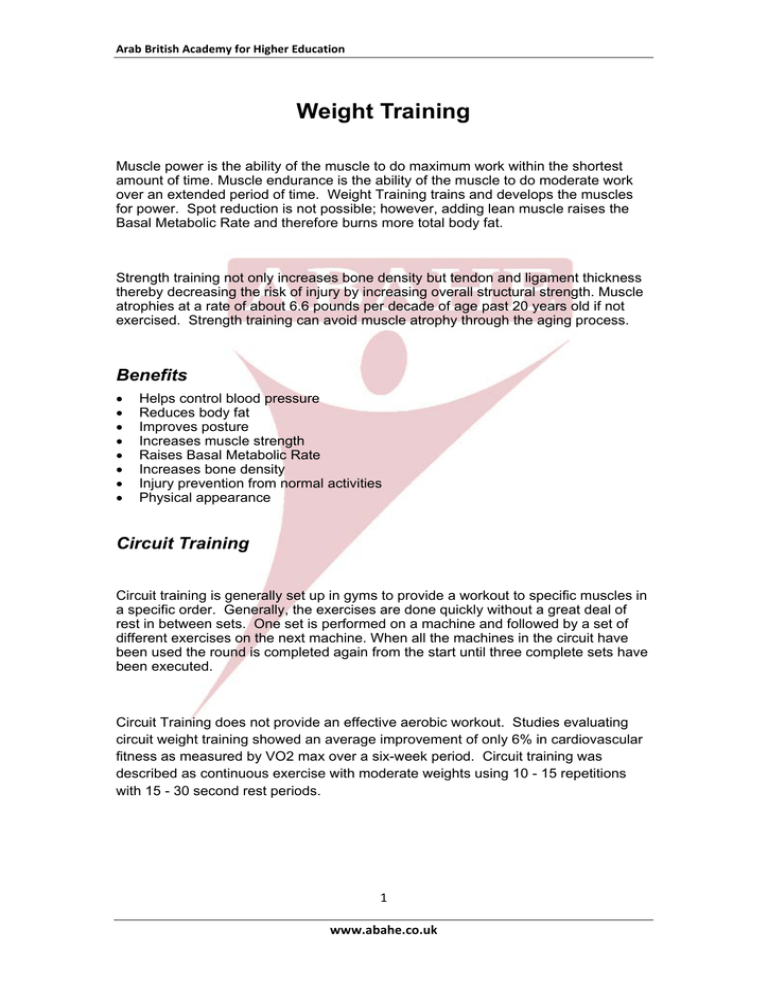
Arab British Academy for Higher Education Weight Training
Muscle power is the ability of the muscle to do maximum work within the shortest
amount of time. Muscle endurance is the ability of the muscle to do moderate work
over an extended period of time. Weight Training trains and develops the muscles
for power. Spot reduction is not possible; however, adding lean muscle raises the
Basal Metabolic Rate and therefore burns more total body fat.
Strength training not only increases bone density but tendon and ligament thickness
thereby decreasing the risk of injury by increasing overall structural strength. Muscle
atrophies at a rate of about 6.6 pounds per decade of age past 20 years old if not
exercised. Strength training can avoid muscle atrophy through the aging process.
Benefits
Helps control blood pressure
Reduces body fat
Improves posture
Increases muscle strength
Raises Basal Metabolic Rate
Increases bone density
Injury prevention from normal activities
Physical appearance
Circuit Training
Circuit training is generally set up in gyms to provide a workout to specific muscles in
a specific order. Generally, the exercises are done quickly without a great deal of
rest in between sets. One set is performed on a machine and followed by a set of
different exercises on the next machine. When all the machines in the circuit have
been used the round is completed again from the start until three complete sets have
been executed.
Circuit Training does not provide an effective aerobic workout. Studies evaluating
circuit weight training showed an average improvement of only 6% in cardiovascular
fitness as measured by VO2 max over a six-week period. Circuit training was
described as continuous exercise with moderate weights using 10 - 15 repetitions
with 15 - 30 second rest periods.
1 www.abahe.co.uk Arab British Academy for Higher Education Overload Principle
Each individual's capabilities are determined by their genetic makeup. Individuals
with increased neuromuscular efficiency incorporate greater numbers of muscle
fibers during contraction and therefore have the advantage in strength potentials. In
general, men have more testosterone than women and therefore have a greater
potential for accelerated growth.
Muscles have a tendency to adapt to repeated stimulus, thereby, requiring less
energy and effort to execute the same task. This can inhibit muscle growth
(hypertrophy) or fat loss that we are trying to achieve. There are two types of
overload principles:
Increasing Weights - increases muscle size.
Increasing Repetitions - increases muscle strength with less growth in size.
If you over-stimulate the muscle, growth in strength and size will be inhibited. The
levels of over-stimulation are dependent on each individual. It would be unreasonable
to double the amount of weights. Make sure that you can do at least 4 to 6
repetitions.
Specificity Principle
Muscle training for a specific task is called specificity. Although each person has
individual variations in movement for sports related activities, specific training
essentially involves working the muscles in the same manner as the expected use.
Muscle design evolves for a specific use. Care must be used when isolating specific
muscles not to create an unbalanced condition. Unbalanced muscles may allow a
particular muscle to work harder than the supporting and stabilizing muscles,
thereby, increases the chances of injury.
Types of Specificity Principles:
Resistance - resistance is identical to or greater than encountered during the
activity or sport.
Movement - movement patterns mimic that encountered during the activity or
sport.
Muscle - specific muscles are exercised that will be used during the sport or
activity.
Speed - movement matches speed used during the activity or sport.
2 www.abahe.co.uk Arab British Academy for Higher Education All Rights Reserved © Arab British Academy for Higher Education 3 www.abahe.co.uk








